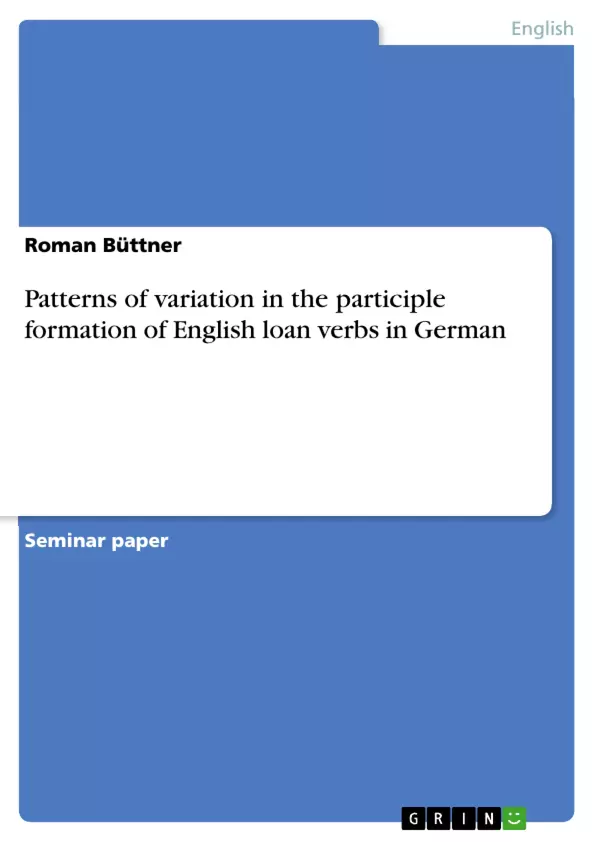In the last decades, modern English has evolved into one of the dominant world languages of science and technology, sports and pop culture. In that it also has a growing influence on other languages such as German. Recent linguistic research has not yet been able to come up with the actual percentage of anglicisms in modern German. Linguists like Zifonun and Kirkness do however estimate that 11-40 % of all neologisms that enter the German language are of English origin. The biggest word class among these are nouns because their morphosyntactic integration into the target language does not pose too great a problem for speakers of German. This is different with verbs: their morphological structure is more complicated than that of nouns due to their wider system of inflectional paradigms. In comparison to German, English syntax is much stricter which results in different syntactic treatments of verbs in both languages. Besides, nowadays the only productive class among these consists of the regular weak verbs. All new loans are incorporated into this class and must therefore rigorously follow its inflectional paradigms. In that, the integration of verbal anglicisms into German is different from the integration of nouns which provides a fruitful area of linguistic research. After all, they account for 10-20 % of all anglicisms, as linguist Stephanie Bohmann is said to have found out.
The aim of this term paper is to take a look at variation in the formation of the past participle (“Partizip II”) of English verbs in German. For that purpose I will start with an introduction to previous research in that specific field, answering the general question how the past participle is formed in German and where problems may occur with verbal anglicisms. In a next step I will present the empirical study I conducted and the results collected from it in order to get a deeper insight into morphosyntactic variation in the process of word integration.
Inhaltsverzeichnis (Table of Contents)
- Introduction
- Previous Research
- The Past Participle in German and its Application to Verbal Anglicisms
- Empirical Study on Variation Patterns
- Methodology
- Presentation and Analysis of Results
- Interpretation of Results and Comparison to Scherer's Study
- Conclusion
- References
- Appendix
Zielsetzung und Themenschwerpunkte (Objectives and Key Themes)
This term paper aims to examine the variation in the formation of the past participle ("Partizip II") of English verbs in German. It will delve into previous research on the integration of English loan verbs into German, focusing on the challenges posed by their morphological structure. The paper will then present an empirical study conducted to understand the morphosyntactic variation patterns observed during word integration.
- The influence of English loan verbs on the German language.
- The integration of verbal anglicisms into German morphology and syntax.
- The formation of the past participle ("Partizip II") of English verbs in German.
- The role of previous research in understanding the integration of English loan verbs.
- The analysis of morphosyntactic variation patterns in the integration of English loan verbs.
Zusammenfassung der Kapitel (Chapter Summaries)
The Introduction provides an overview of the increasing influence of English on the German language, highlighting the challenges posed by the integration of English verbs into German morphology and syntax. It introduces the research question concerning the formation of the past participle ("Partizip II") of English verbs in German and outlines the structure of the paper.
The chapter on "Previous Research" discusses the limited research on the integration of English verbs into German, particularly compared to the focus on nouns. It highlights the contributions of linguists like Geller, Scherer, and Onysko in understanding the morphosyntactic and phonological integration of English loan words, specifically focusing on the past participle formation.
The chapter on "The Past Participle in German and its Application to Verbal Anglicisms" presents the theoretical background of the past participle formation in German. It explores the grammatical function, meaning, and morphological structure of the past participle, particularly in relation to the stress pattern and the three verb types: simplex verbs, prefixed verbs, and particle verbs.
Schlüsselwörter (Keywords)
The primary keywords and focus topics of this paper include: verbal anglicisms, past participle formation, morphosyntactic variation, integration of loan words, German morphology, English loan verbs, and research on anglicisms in German.
- Quote paper
- Roman Büttner (Author), 2007, Patterns of variation in the participle formation of English loan verbs in German, Munich, GRIN Verlag, https://www.grin.com/document/90945



